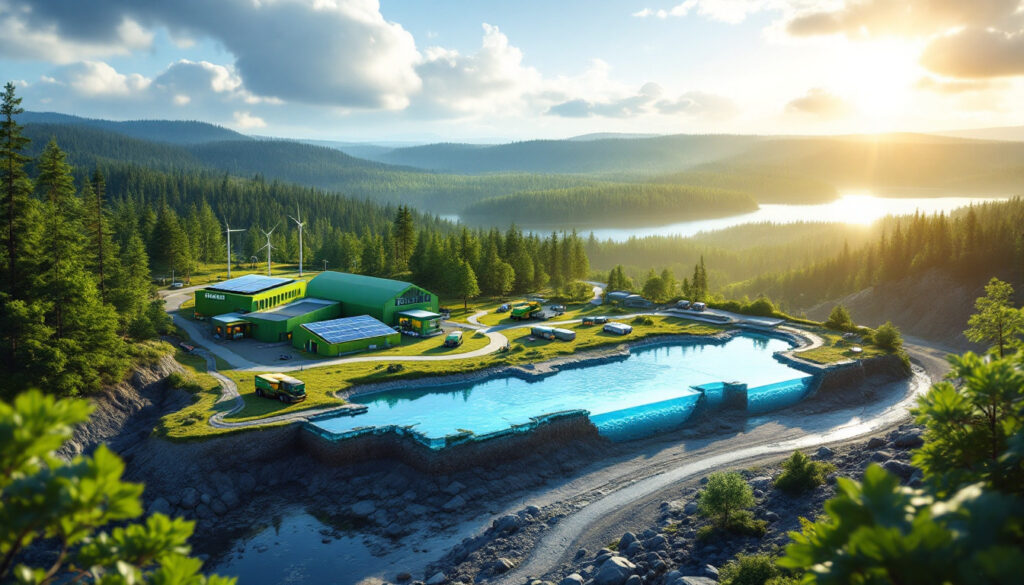Introduction: Understanding Green Design and Energy in Mining
Green design in the mining context refers to a holistic approach that minimizes environmental impacts through innovative engineering, resource efficiency, and ecosystem preservation. Renewable energy, meanwhile, encompasses the integration of sustainable power sources like solar, wind, and hydroelectric into mining operations, replacing traditional fossil fuel dependency. These concepts have moved from aspirational to essential as the global mining industry faces increasing pressure to reduce its environmental footprint.
The mining sector currently accounts for 4-7% of global greenhouse gas emissions, making decarbonisation in mining not just environmentally responsible but economically necessary. As regulatory frameworks tighten and stakeholder expectations evolve, mining companies are reimagining their operational models to align with climate goals.
Wyloo Metals' Eagle's Nest project in Northern Ontario's Ring of Fire region exemplifies this shift, setting new benchmarks for sustainable mining. With a projected footprint of less than 1 square kilometer—compared to the industry average of 5-10 square kilometers for similar operations—it represents a paradigm shift in how critical mineral extraction can be accomplished with minimal environmental disruption.
What Does Green Design in Mining Entail?
Green mine design fundamentally rethinks every aspect of traditional mining approaches, from initial exploration to site rehabilitation. This design philosophy centers on minimizing ecological disturbance while maximizing resource recovery and operational efficiency.
Key Principles of Green Mine Design
The cornerstone of green design and energy in mining is minimizing surface disturbance. Wyloo Metals' Eagle's Nest project exemplifies this approach with its target footprint of less than 1 square kilometer—a fraction of conventional mining operations. This reduced footprint preserves biodiversity, minimizes habitat fragmentation, and maintains ecosystem integrity in the sensitive northern environment.
Water conservation represents another crucial element, with Wyloo targeting an 85% water recycling rate compared to the industry average of 45%. This approach not only reduces freshwater withdrawal but minimizes potential contamination of surrounding watersheds—a critical consideration in the ecologically significant Ring of Fire region.
Perhaps most innovative is the project's approach to mine waste management. Rather than creating conventional surface tailings ponds, Eagle's Nest plans to implement underground tailings deposition—a method that returns processed material to excavated areas of the mine. This technique reduces surface water contamination risk by an estimated 92% while ensuring long-term geological stability.
"We've re-engineered every system to function within bedrock geology," explains Kristan Straub, CEO of Wyloo Metals Canada. "Underground tailings placement essentially returns materials to their source, dramatically reducing environmental risk."
Spotlight: Eagle's Nest Project by Wyloo Metals
Located in Northern Ontario's mineral-rich Ring of Fire, Eagle's Nest represents one of North America's most significant undeveloped nickel sulfide deposits. The project targets annual production of approximately 1 million tonnes of nickel, copper, and platinum group metals over a projected 17-year mine life.
What sets Eagle's Nest apart is its integration of multiple sustainable mining innovations:
- A compact design that centralizes operations to minimize surface disturbance
- Underground tailings management that eliminates conventional tailings ponds
- Efficient water management systems that drastically reduce freshwater requirements
- Strategic planning for mine closure and rehabilitation from the design phase
"Our upcoming feasibility study for Eagle's Nest envisions minimizing impact through a project footprint of under 1 sq. km and significantly reduced water usage," states Kristan Straub, CEO of Wyloo Metals Canada.
The Integration of Renewable Energy in Mining
The mining industry's energy-intensive nature—from excavation to processing—has traditionally tied it to fossil fuels, particularly in remote locations. However, technological advancements and falling costs have made renewable energy integration increasingly viable, even in challenging northern environments.
What Types of Renewable Energy are Suitable for Mining Operations?
Solar power, once considered impractical for northern mining sites, has become increasingly viable through technological improvements and falling costs. Hybrid solar systems have demonstrated the ability to cut diesel consumption by up to 70% in remote operations, even in regions with seasonal daylight variations.
Wind energy offers complementary benefits, particularly in northern regions where wind resources are often abundant. Modern turbines can operate effectively in extreme conditions, providing consistent power generation during winter months when solar production decreases.
Battery storage technologies have evolved to address intermittency challenges, with current systems capable of providing 72-hour backup capacity to ensure operational continuity. These systems have become increasingly cost-competitive, with lifecycle costs now comparable to diesel generator installations in many scenarios.
Hydropower remains viable where geography permits, offering reliable baseload capacity with minimal ongoing fuel costs. Small-scale run-of-river installations can provide consistent power without the environmental impacts associated with large dam projects.
Case Study Example: Eagle's Nest Green Energy Initiative
Eagle's Nest aims to achieve a 60% renewable energy mix by 2030, significantly reducing its carbon footprint while enhancing operational resilience. This approach combines:
- Microgrid technology that integrates multiple energy sources
- AI-driven load management systems that optimize energy use based on operational demands
- Strategic battery storage deployment to ensure reliability
- Phased transition from diesel to renewable sources
"Renewables now compete with diesel on cost-per-kilowatt-hour in northern latitudes," notes a recent Mining Energy Consortium report. "The economic case is as compelling as the environmental one."
The anticipated benefits extend beyond emissions reduction. By reducing diesel transportation requirements, the project will minimize heavy vehicle traffic, further reducing its environmental footprint and operational costs. This approach is expected to prevent approximately 450,000 tonnes of CO2 equivalent emissions annually once fully implemented.
Why is Transparency Crucial in Sustainable Mining?
Transparency has emerged as a defining factor in mining project success, particularly for operations in environmentally sensitive regions or near Indigenous communities. Beyond ethical considerations, transparency functions as a strategic risk management approach.
"Glass Box Approach" Versus "Black Box Approach"
Wyloo Metals has pioneered what it terms the "Glass Box Approach" to project development and operation. This model contrasts sharply with the traditional "Black Box Approach" that characterized mining operations for generations.
The Glass Box Approach fundamentally changes information dynamics between mining companies and stakeholders. Rather than treating operational data as proprietary, this model proactively shares environmental metrics, community impacts, and operational details with affected communities and regulatory bodies. This transparency creates mutual understanding, facilitates informed discussion, and builds trust through information symmetry.
| Factor | Glass Box Approach (Wyloo) | Black Box Approach (Conventional) |
|---|---|---|
| Data Sharing | Frequent, detailed, proactive | Annual, generalized |
| Community Engagement | Ongoing, collaborative | Limited, reactionary |
| Trust Levels | High community trust | Lower community trust |
| Regulatory Benefits | Streamlined permitting | Potential delays |
The business case for transparency is compelling. Projects employing Glass Box approaches secure permits up to 40% faster than those operating under conventional disclosure models. This acceleration stems from reduced opposition, more efficient regulatory reviews, and fewer information requests during assessment processes.
"By reducing information asymmetry through our Glass Box Approach, trust-building with local and Indigenous communities becomes stronger, speeding up project approvals and community integration," explains Kristan Straub, CEO of Wyloo Metals Canada.
Advanced monitoring technologies enable this transparency. Real-time water quality dashboards, accessible to community representatives, provide immediate visibility into environmental performance. Similarly, air quality monitoring, noise level tracking, and wildlife movement data create a comprehensive picture of a project's ecological footprint.
How is Green Mining Transforming Community Relations?
The integration of sustainable practices has fundamentally reshaped relationships between mining operations and local communities, particularly Indigenous groups with traditional territorial interests.
Collaboration with Indigenous and Local Communities
In Canada's Ring of Fire region, engagement with Indigenous communities has evolved from consultation to partnership. Approximately 63% of projects now incorporate revenue-sharing agreements—nearly triple the global average of 22%—creating economic alignment between mining companies and Indigenous nations.
These partnerships extend beyond financial considerations to include active participation in environmental monitoring, cultural heritage protection, and rehabilitation planning. This collaborative approach recognizes Indigenous knowledge systems as valuable complements to technical expertise, particularly in understanding complex ecological relationships.
"Co-design isn't consultation—it's co-ownership of outcomes," notes a representative from the Matawa First Nations, highlighting the distinction between tokenistic engagement and meaningful partnership.
Wyloo Metals' approach includes ambitious employment targets, with over 200 Indigenous positions planned during construction phases and long-term training programs to develop technical skills within local communities. These initiatives have been designed collaboratively with affected communities to align with their development priorities and cultural values.
Hypothetical Scenario: Community Integration
The transformation of community relations can be illustrated through a typical project development timeline:
- Pre-development: Indigenous communities participate in baseline environmental studies, incorporating traditional knowledge alongside scientific measurement.
- Design phase: Community priorities influence infrastructure placement, operational scheduling, and protection of cultural sites.
- Construction: Local businesses receive preferential contracting opportunities, while targeted training programs prepare community members for operational roles.
- Operation: Joint environmental monitoring committees provide ongoing oversight, while profit-sharing agreements deliver direct economic benefits.
- Closure planning: Indigenous perspectives guide rehabilitation approaches, ensuring land restoration aligns with traditional uses.
This integrated approach creates multiple benefits: communities gain economic opportunities and environmental protection, while mining companies experience streamlined approvals, reduced conflicts, and enhanced social license to operate.
What are the Environmental and Economic Benefits of Sustainable Mining?
Sustainable mining practices deliver a spectrum of environmental and economic advantages that mutually reinforce one another, creating a compelling business case for green design implementation.
Environmental Advantages
The ecological benefits of sustainable mining begin with dramatic reductions in land disturbance. Eagle's Nest's sub-1 km² footprint represents less than 20% of conventional operations of similar scale, preserving biodiversity and maintaining ecosystem integrity in surrounding areas.
Water management improvements offer equally significant benefits. Underground tailings deposition eliminates the risk of catastrophic dam failures while reducing potential contamination pathways. When combined with closed-loop water systems, these approaches minimize impacts on surrounding watersheds—critical in regions with interconnected hydrological systems.
Greenhouse gas reductions through renewable energy integration represent perhaps the most significant environmental benefit. Eagle's Nest's renewable energy strategy is projected to prevent approximately 450,000 tonnes of CO2 equivalent emissions annually—comparable to removing 100,000 passenger vehicles from circulation.
Biodiversity preservation represents another critical advantage. By minimizing the physical footprint and implementing comprehensive wildlife management plans, sustainable mines can maintain habitat continuity and reduce fragmentation effects that threaten sensitive species.
Economic Advantages
The economic case for sustainable mining has strengthened considerably as technology costs have declined and regulatory requirements have tightened. While green design typically increases initial capital expenditure by 15-20%, it delivers operational expenditure reductions averaging 35% over project lifetimes.
These cost advantages come from multiple sources:
- Reduced energy costs once renewable infrastructure is amortized
- Lower water treatment expenses through recycling and contamination prevention
- Decreased regulatory compliance costs and surety bond requirements
- Accelerated permitting timelines producing earlier revenue generation
- Reduced closure and reclamation liabilities
When carbon pricing mechanisms are factored in—with Canada's carbon price scheduled to reach $170/tonne by 2030—the economic case becomes even more compelling. Under current projections, sustainable operations will enjoy a $25-30 per tonne processed advantage over conventional approaches by mid-decade.
"The sustainable mine isn't just environmentally superior—it's economically advantaged in virtually every jurisdiction with robust environmental regulations," notes a recent analysis from S&P Global Market Intelligence.
Summarized Key Statistics (Eagle's Nest Example)
- Annual Production Capacity: ~1 million tonnes of critical minerals (nickel, copper, platinum group metals)
- Project Footprint: Under 1 square kilometer
- Project Duration: 17-year projected mine life
- Water Recycling Rate: 85% (vs. industry average of 45%)
- GHG Reduction: 450,000 tonnes CO2e annually when fully implemented
- Renewable Energy Target: 60% of total energy consumption by 2030
FAQ: Common Questions About Green Design and Renewable Energy in Mining
What Defines a Green Mine?
A green mine integrates comprehensive sustainability practices throughout its lifecycle, characterized by minimal surface disturbance, efficient resource utilization, waste minimization, renewable energy integration, and transparent community engagement. Unlike conventional operations that address ESG challenges in mining primarily through mitigation, green mines incorporate sustainability into their fundamental design parameters, optimizing environmental performance from inception through closure.
How Does Renewable Energy Integration Impact Mining Costs?
Renewable energy integration typically increases initial capital expenditure by 12-18% but reduces operational energy costs by 40-60% over project lifetimes. The payback period for renewable infrastructure averages 7 years—longer than the 4-year typical payback for diesel systems—but delivers significant advantages over operations exceeding a decade. Additionally, renewable systems eliminate fuel price volatility, providing greater cost certainty for long-term planning and reducing transportation-related environmental impacts in remote locations.
What Innovative Waste Management Techniques Exist for Mines?
Underground tailings storage represents the most significant waste management innovation, returning processed material to excavated chambers with specialized geotechnical properties that ensure long-term stability. This approach eliminates conventional tailings ponds and their associated risks while reducing surface disturbance. Additional innovations include paste backfill incorporating industrial by-products, progressive rehabilitation that restores ecosystems concurrently with operations, and advanced filtration systems that enable near-total water recycling from process streams.
Comparing Conventional and Sustainable Mining Designs
The contrast between conventional and sustainable mining approaches extends across virtually every operational dimension, from energy sources to community engagement frameworks.
Comparison Table: Conventional Mining vs. Green Mining Approaches
| Aspect | Conventional Mining Methods | Sustainable (Green) Mining Methods |
|---|---|---|
| Energy Sources | Diesel, fossil fuels | Renewable sources like solar/wind |
| Waste Management | Surface tailings ponds | Underground tailings, recycled water usage |
| Footprint Size | Large environmental impacts | Minimized impacts (less than 1 sq. km) |
| Community Engagement | Minimal and reactionary | Extensive and proactive "glass box" model |
| Greenhouse Gas Emissions | High | Significantly Lower |
| Water Usage (per tonne) | 4.2 m³ industry average | 1.5 m³ in optimized operations |
| Initial Capital Costs | Lower | 15-20% higher |
| Operating Costs | Higher long-term expenses | Average 35% lower |
| Closure Liabilities | Extensive, long-duration | Reduced through progressive rehabilitation |
| Regulatory Timeline | Extended, often contested | Accelerated through transparency |
This comparison highlights the fundamental shift occurring across the mining sector—from a model focused primarily on extraction efficiency to one balancing environmental, social, and economic considerations through integrated design approaches.
Future Trends: What is Next in Green Mining Design?
The evolution of sustainable mining continues to accelerate, driven by technological innovation, regulatory developments, and shifting stakeholder expectations.
Emerging Technologies and Methodologies
Battery electric equipment represents perhaps the most transformative development in underground mining, eliminating diesel particulate matter while reducing ventilation requirements and associated energy consumption. With approximately $17 billion invested in mining digital transformation between 2023-2025, this transition is rapidly gaining momentum across the industry.
Artificial intelligence applications are similarly transformative, enhancing both environmental and operational performance. AI-driven ore sorting systems have demonstrated 12% improvements in recovery rates, reducing energy consumption per tonne of metal produced while minimizing waste rock generation. Similarly, predictive maintenance algorithms optimize equipment performance while reducing consumable use and unplanned downtime.
Geothermal energy holds particular promise for mining operations. As a recent International Energy Agency Mining Energy Outlook noted, "Geothermal could displace 90% of process heat requirements by 2040," providing consistent, carbon-free energy for processing applications currently dependent on fossil fuels.
Hydrogen technologies are advancing rapidly, with BHP's Chilean copper operations piloting hydrogen-powered haulage equipment that could eliminate diesel use in open-pit environments. While still emerging, these systems demonstrate potential pathways toward zero-emission surface operations even in remote locations.
Global Industry Shifts Towards Sustainability
Major mining companies have accelerated sustainability commitments in response to investor pressure, regulatory changes, and mounting climate concerns. Rio Tinto's solar-battery microgrid at Diavik Mine demonstrated a 30% emissions reduction, providing real-world validation for renewable energy integration in subarctic environments.
Regulatory frameworks increasingly incentivize sustainable practices, with the U.S. Inflation Reduction Act providing substantial tax benefits for domestic critical mineral production meeting environmental standards. Similarly, the European Union's Carbon Border Adjustment Mechanism will impose carbon pricing on imported materials, creating competitive advantages for low-emission operations.
Financial markets have reinforced these shifts, with ESG-focused investment funds increasingly overweighting mining companies demonstrating sustainability leadership. This capital flow advantage creates a virtuous cycle, accelerating adoption of innovative approaches across the sector.
Conclusion: Paving the Way Toward Sustainable Mining Operations
The transformation under
Want to Capitalise on the Next Major Mineral Discovery?
Discovery Alert's proprietary Discovery IQ model instantly notifies you of significant ASX mineral announcements, transforming complex data into actionable investment insights before the wider market responds. Visit our discoveries page to see how historical discoveries have generated substantial returns and begin your 30-day free trial today.




